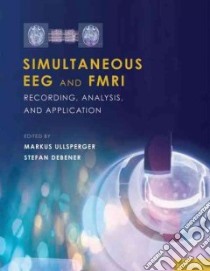Simultaneous Eeg and Fmri - 9780195372731
Un libro in lingua di Ullsperger Markus M.D. Ph.D. (EDT) Debener Stefan Ph.D. (EDT) edito da Oxford University Press, 2010
- € 147.20
- Il prezzo è variabile in funzione del cambio della valuta d’origine
Systemic interactions in brain networks have been successfully studied in vivo using non-invasive methods such as electroencephalography (EEG) and functioned magnetic resonance imaging (IMRI) for many years. The rate-limiting step however, is that each methods can only map selective aspects of brain function while missing others key aspects. Furthermore, the inferences on neuronal processes and information flow are often rather indirect. By simultaneously combining both methods, the researcher is better able to make optimal use of their specific advantages while compensating for their disadvantages.
As a result of the technical issues that have been solved, and readily available commercial equipment, research has shifted and expanded from demonstrating technical feasibility to methodological issues of artifact control, new ways of analyzing and integrating data, and to applications for scientific and clinical questions. Combined EEG and fMRI methods now cover everthing from physiological questions on the bases of the two recorded signals to more specific questions on the mechanisms of certain cognitive and pathological functions like epileptic brain activity.
Simultaneous EEG and fMRI provides the interested researcher with the tools to establish a simultaneous EEG-fMRI laboratory as well as for those scientists who are interested in integrating electrophysiological and hemodynamic data. As evidenced by the diversity of topics presented, this is a dynamically developing field in which several appraches are being tested, validated, and compared. Chapters are dedicated to the physiological bases of the measured signals, technical setup, sources of artifacts and data de-noising, various approaches of data analysis and fusion, as well as applications, In addition, open questions and directions for future research are outlined.
"This book is a four de force of the application of EEG and fMRI to human nevroscience. The editors have covered all the requisite knowledge in EEG and fMRI and provide an elegant approach to simultaneous EEG-fMRI recording. Importantly, they also provide a guideling on how to integrate EEG and fMRI dafasets and delineate the current and future strengths and applications that can be derived from simultaneous recording. This book will become standard reading for both new initiates and seasoned researchers in the burgeoning field of human neurobiology."
Informazioni bibliografiche
- Titolo del Libro in lingua: Simultaneous Eeg and Fmri
- Sottotitolo: Recording, Analysis, and Application
- Lingua: English
- Autori : Ullsperger Markus M.D. Ph.D. (EDT) Debener Stefan Ph.D. (EDT)
- Editore: Oxford University Press
- Collana: Oxford Univ Pr (Hardcover)
- Data di Pubblicazione: 28 Maggio '10
- Genere: MEDICAL
- Argomenti : Electroencephalography Brain Magnetic resonance imaging Electroencephalography
- Pagine: 315
- ISBN-10: 0195372735
- EAN-13: 9780195372731


